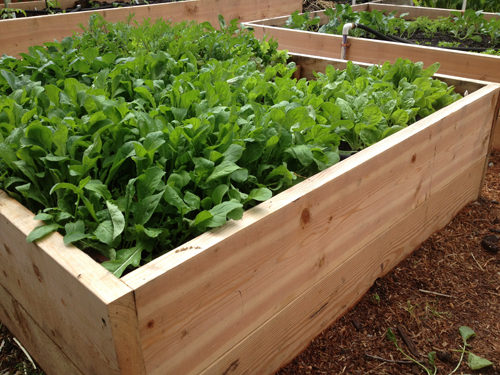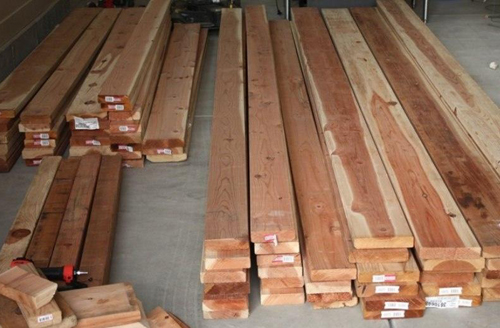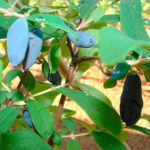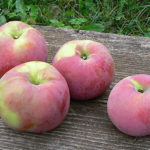How to treat the boards for the beds from decay?
Recently, bulk beds with wooden crate have gained particular popularity. Such designs have a number of advantages. For example, a wooden box reliably protects the ridge from erosion (soil leaching) - this is especially true on slopes. This design is easy to equip with a drip irrigation system. Calculation and distribution of fertilizers is greatly simplified

In addition to the advantages, beds in a wooden box have one drawback - organic material (boards) is prone to rotting in conditions of high humidity. Thus, a reasonable question arises: what should be used to treat the boards to avoid rotting?
Folk methods of protecting wood from decay
If there was a question about the processing of building material, then there are many options that, unfortunately, are not suitable for wooden equipment of high beds. First, the protective composition must be environmentally friendly, that is, it must not poison the soil or cause allergies.
- Bitumen treatment. The essence of the method is to coat the wood with molten bitumen. The protective coating will last for a long time. The disadvantages include the laboriousness and unaesthetic appearance of the boards, therefore, it is advisable to carry out such processing for the underground part of the structure.
- Protective coating based on wax, natural oil and propolis. The composition is prepared from 3 parts of natural oil, 2 parts of wax and 1 part of propolis. This method of processing is highly efficient, although it has an important disadvantage - high cost.

- Protective coating based on cement and water glass. "Liquid glass" (sodium or potassium silicates) is used in construction to impart water-repellent properties to cement plaster, for example, for a pool. "Liquid glass" dissolves quite well in water, but after drying, an insoluble compound is formed. To prepare the composition, it is necessary to take cement and "liquid glass" in a ratio of 3: 1, stir thoroughly in water until a mixture of a liquid consistency is obtained. You can process the board with a paint brush, or use a construction spray gun (spray). After processing, the boards must be placed vertically to dry (from 5 days or more). The effectiveness of the method is commensurate with the financial costs. The treatment can be carried out without the use of cement.
- Processing with PVA glue. The method is characterized by high efficiency and relatively low cost. After drying, a stable, water-insoluble transparent film forms. Polymerization takes place better under the influence of ultraviolet radiation.
- Processing with an alcoholic solution of rosin. Despite the relatively high cost, where the main share of financial costs is the purchase of alcohol, the method deserves attention. An alcoholic solution of rosin (you can use the resin of coniferous trees) has high adhesion (sticking ability) and, after drying, forms a strong protective film that reliably protects the wood from decay. For preparation, it is necessary to add 1/3 part of rosin powder to alcohol and mix thoroughly until dissolved. The composition should have the consistency of a liquid glue. You can add a little turpentine to the composition (its smell will drive cats away from the beds). The adhesive solution is applied with a brush. After a day, the boards can be used to equip the beds.

Using vitriol to protect wood
In horticulture, vitriol (copper and iron) is widely used - these substances are successfully used to protect wood from decay.
- Impregnation of wood with vitriol. For processing, it is necessary to prepare a saturated solution of copper or iron sulfate. You will also have to build a "font" from a plastic film, into which you will need to put the material to be processed and pour the prepared solution. Duration of processing is 1-2 days (or more). At the end of the impregnation, the boards must be thoroughly dried. Treated with vitriol, they will last a long time, in addition, copper ions (if copper sulfate was used) have a detrimental effect on pathogenic soil microorganisms. Attention! Copper sulfate must not be poured into aluminum containers and containers made of rusty iron!
Finnish method of protecting wood from decay
Composition for processing: 10 liters of water, 1 part of sodium chloride, 2 parts of flour and 4 parts of lime and ferrous sulfate (ferrous sulfate). First, you need to dissolve all the salts and stir thoroughly. Flour is mixed in small portions into a heated solution - you should get a paste. At the last stage, slaked lime is added to the paste. The composition is applied to wooden surfaces in a warm state. The use of copper sulfate is allowed. To prepare the composition, vitriol is first dissolved, then salt is added, and at the end of the reaction (the liquid turns green due to the formation of copper chloride), the remaining components are introduced. Attention! Lime is added only to the paste, but not to the salt solution, otherwise a chemical reaction will occur with the formation of an insoluble precipitate of carbonates.
Wood preparation and surface treatment
- The board to be processed must be well dried. Drying is carried out in stacks under awnings. Planks are laid in layers, alternating with metal rods to ensure air flow.
- The surface of the board must be cleaned of dust and burrs, ideally with a plane.
- For aesthetics, the front surface of the board can be burned with a blowtorch or stained. Such processing is appropriate only if it is supposed to use a transparent protective layer (vitriol, alcohol-rosin, silicates, PVA glue).








